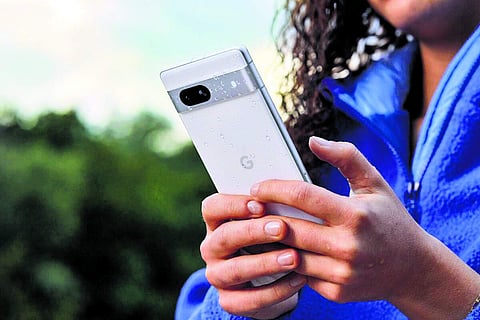
- LIFESTYLE
- FASHION
- FOOD
- ENTERTAINMENT
- EVENTS
- CULTURE
- VIDEOS
- WEB STORIES
- GALLERIES
- GADGETS
- CAR & BIKE
- SOCIETY
- TRAVEL
- NORTH EAST
- INDULGE CONNECT

Google’s Pixel A series fulfils a simple premise each year – deliver the ‘Android as it was intended’ software experience and imaging wizardry for less money than its more expensive, numbered series siblings. And so it goes with this year’s Pixel 7a, Google’s pocket-friendly alternative to its flagship duo (Pixel 7/7 Pro) that lands decidedly in the mid-range segment (INR 43,999) while offering a lot of what one liked in the Pixel 7 for just a bit less. A Pixel 7-lite, perhaps… but is it worth the money?
Borrowing heavily from the Pixel 7’s minimalist, two-tone look with that distinctive Robocop-style visor on the rear, the Pixel 7a looks nearly indistinguishable from the 7. It comes in the usual Charcoal (black) and Snow (white) colours, but this year’s colour to pick is Sea (blue). There are a few corners cut, however – the tactile alloy material for the visor doesn’t merge with the side frame quite as seamlessly, the 3D thermoformed plastic on the rear feels like glass but it isn’t, and Gorilla Glass 3 is used instead of Gorilla Glass Victus on the display. On the bright side, the 7a offers both IP67 dust and water resistance and wireless charging, which continue to be rare features for the price segment. Despite relatively similar dimensions, Google has used a slightly smaller 6.1-inch display which makes the 7a easier to hold and use one-handed.
Last year’s Pixel 6a was soundly criticised for its less-fluid 60Hz display, and the 7a rights that wrong with a 1080x2400 pixel 90Hz OLED display that’s very similar to the one used on the Pixel 7, if a little less bright than I’d have liked for outdoor use. Right from the stock Android UI animations to scrolling within apps, the experience is fluid, and the haptics and fingerprint unlock are about par for the course as well.
As with the Pixel 7 series, the Pixel 7a uses Google’s flagship Tensor G2 chipset with a single 8GB/128GB variant. The single storage variant may not be enough for everyone, particularly if you use the phone a lot for photos and video (as you should). The Tensor G2 is a step up in terms of power and efficiency compared to the first-generation Tensor chip, and while it allows new camera and Pixel-exclusive photo editing features (like Photo Unblur, Magic Eraser), it’s not quite in the same league as the top chips from Qualcomm and MediaTek. Sure, it manages games like Call of Duty: Mobile at high settings, but it’s let down on sustained performance and runs hot, almost uncomfortably so often in the summer. For everyday use with the odd short gaming session, the Pixel 7a could last a day or around 5.5 hours of screen time, which isn’t bad for a phone this size. Charging is a tad slow at 18W speeds.
Yet, we all know most folks consider Pixels for their camera smarts and the ability to pull out magical results from commodity hardware. There’s a new 64-megapixel Sony IMX787 sensor leading the charge on the 7a, along with a 13-megapixel ultrawide with a wide 120-degree field of view. It shoots pictures with better colours and white balance than the pricier Pixel 7, and even edges ahead in terms of details on low-light shots, but the larger pixel size on the 7 yields better details in well-lit shots, along with comparably better videos.
Knowing Google’s propensity to drop Pixel pricing during festive sales, you’d do well to wait for the 7a to benefit from an even lower pricing, or pick up the Pixel 7 at its often discounted price for its bigger display and slightly better design, durability and charging speeds. Outside of Google’s stable, there is the OnePlus 11R and the Nothing Phone (1) to consider.
Rating: 8/10
Price: INR 43,999